New Electrospun ZnO:MoO3 Nanostructures: Preparation, Characterization and Photocatalytic Performance
Abstract
1. Introduction
2. Materials and Methods
2.1. Materials
2.2. Preparation of ZnO:MoO3 Nanostructures
2.3. Structural Characterization
2.4. Steady-State Spectral Measurements
2.5. Time-Resolved Fluorescence
2.6. Nanosecond Transient Absorption Spectroscopy
2.7. Photocatalysis Tests
3. Results and Discussion
3.1. Morphological Characterization
3.2. X-ray Diffraction (XRD) Analysis
3.3. Optical Properties
3.4. Time-Resolved Photoluminescence Data and International Commission on Illumination (CIE) Coordinates
3.5. Nanosecond Time-Resolved Absorption Data
3.6. Photocatalytic Properties
4. Conclusions
Author Contributions
Funding
Conflicts of Interest
References
- Pascariu, P.; Homocianu, M. ZnO-Based ceramic nanofibers: Preparation, properties and applications. Ceram. Int. 2019, 45, 11158–11173. [Google Scholar] [CrossRef]
- Türkyılmaz, Ş.Ş.; Güy, N.; Özacar, M. Photocatalytic efficiencies of Ni, Mn, Fe and Ag doped ZnO nanostructures synthesized by hydrothermal method: The synergistic/antagonistic effect between ZnO and metals. J. Photochem. Photobiol. A Chem. 2017, 341, 39–50. [Google Scholar] [CrossRef]
- Pascariu, P.; Airinei, A.; Olaru, N.; Olaru, L.; Nica, V. Photocatalytic degradation of Rhodamine B dye using ZnO–SnO2 electrospun ceramic nanofibers. Ceram. Int. 2016, 42, 6775–6781. [Google Scholar] [CrossRef]
- Pascariu, P.; Tudose, I.V.; Suchea, M.P.; Koudoumas, E.; Fifere, N.; Airinei, A. Preparation and characterization of Ni, Co doped ZnO nanoparticles for photocatalytic applications. Appl. Surf. Sci. 2018, 448, 481–488. [Google Scholar] [CrossRef]
- Chithambararaj, A.; Sanjini, N.S.; Velmathi, S.; Bose, A.C. Preparation of h-MoO3 and α-MoO3 nanocrystals: Comparative study on photocatalytic degradation of methylene blue under visible light irradiation. Phys. Chem. Chem. Phys. 2013, 15, 14761–14769. [Google Scholar] [CrossRef]
- Wei, W.; Zhang, Z.; You, G.; Shan, Y.; Xu, Z. Preparation of recyclable MoO3 nanosheets for visible-Light driven photocatalytic reduction of Cr(vi). RSC Adv. 2019, 9, 28768–28774. [Google Scholar] [CrossRef]
- Peña-Bahamonde, J.; Wu, C.; Fanourakis, S.K.; Louie, S.M.; Bao, J.; Rodrigues, D.F. Oxidation state of Mo affects dissolution and visible-Light photocatalytic activity of MoO3 nanostructures. J. Catal. 2020, 381, 508–519. [Google Scholar] [CrossRef]
- Bai, S.; Chen, S.; Chen, L.; Zhang, K.; Luo, R.; Li, D.; Liu, C.C. Ultrasonic synthesis of MoO3 nanorods and their gas sensing properties. Sens. Actuators B Chem. 2012, 174, 51–58. [Google Scholar] [CrossRef]
- Al-Otaibi, A.L.; Ghrib, T.; Alqahtani, M.; Alharbi, M.A.; Hamdi, R.; Massoudi, I. Structural, optical and photocatalytic studies of Zn doped MoO3 nanobelts. Chem. Phys. 2019, 525, 110410. [Google Scholar] [CrossRef]
- Ong, C.B.; Ng, L.Y.; Mohammad, A.W. A review of ZnO nanoparticles as solar photocatalysts: Synthesis, mechanisms and applications. Renew. Sustain. Energy Rev. 2018, 81, 536–551. [Google Scholar] [CrossRef]
- Kim, B.-Y.; Yoon, J.-W.; Lee, C.-S.; Park, J.-S.; Lee, J.-H. Trimethylamine Sensing Characteristics of Molybdenum doped ZnO Hollow Nanofibers Prepared by Electrospinning. J. Sens. Sci. Technol. 2015, 24, 419–422. [Google Scholar] [CrossRef]
- Qamar, M.T.; Aslam, M.; Rehan, Z.; Soomro, M.T.; Ahmad, I.; Ishaq, M.; Ismail, I.M.; Fornasiero, P.; Hameed, A. MoO3 altered ZnO: A suitable choice for the photocatalytic removal of chloro-Acetic acids in natural sunlight exposure. Chem. Eng. J. 2017, 330, 322–336. [Google Scholar] [CrossRef]
- Li, G.R.; Wang, Z.L.; Zheng, F.L.; Ou, Y.N.; Tong, Y.X. ZnO@MoO3 core/shell nanocables: Facile electrochemical synthesis and enhanced supercapacitor performances. J. Mater. Chem. 2011, 21, 4217–4221. [Google Scholar] [CrossRef]
- Saminathanab, D.; Deogratiasa, T.; Thirugnanasambandana, S.; Vengidusamyc, N.; Arumainathana, S.; Dhanavel, S.; Sivaranjani, T.; Narayanan, V.; Stephen, A. Facile synthesis of 1D/1D ZnO@h-MoO3 for enhanced visible light driven photo degradation of industrial textile effluent. Mater. Lett. 2020, 262, 127049. [Google Scholar] [CrossRef]
- Cojocaru, C.; Dorneanu, P.P.; Airinei, A.; Olaru, N.; Samoila, P.; Rotaru, A. Design and evaluation of electrospun polysulfone fibers and polysulfone/NiFe2O4 nanostructured composite as sorbents for oil spill cleanup. J. Taiwan Inst. Chem. Eng. 2017, 70, 267–281. [Google Scholar] [CrossRef]
- Dorneanu, P.P.; Cojocaru, C.; Samoila, P.; Olaru, N.; Airinei, A.; Rotaru, A. Novel fibrous composites based on electrospun PSF and PVDF ultrathin fibers reinforced with inorganic nanoparticles: Evaluation as oil spill sorbents. Polym. Adv. Technol. 2018, 29, 1435–1446. [Google Scholar] [CrossRef]
- Faraz, M.; Naqvi, F.K.; Shakir, M.; Khare, N. Synthesis of samarium-Doped zinc oxide nanoparticles with improved photocatalytic performance and recyclability under visible light irradiation. New J. Chem. 2018, 42, 2295–2305. [Google Scholar] [CrossRef]
- Jia, T.; Wang, W.; Long, F.; Zhengyi, F.; Wang, H.; Zhang, Q. Fabrication, characterization and photocatalytic activity of La-Doped ZnO nanowires. J. Alloys Compd. 2009, 484, 410–415. [Google Scholar] [CrossRef]
- Shaban, M.; Zayed, M.; Hamdy, H. Nanostructured ZnO thin films for self-Cleaning applications. RSC Adv. 2017, 7, 617–631. [Google Scholar] [CrossRef]
- Srikant, V.; Clarke, D.R. On the optical band gap of zinc oxide. J. Appl. Phys. 1998, 83, 5447–5451. [Google Scholar] [CrossRef]
- Tu, Y.F.; Huang, S.Y.; Sang, J.P.; Zou, X.W. Synthesis and photocatalytic properties of Sn-Doped TiO2 nanotube arrays. J. Alloys Compd. 2009, 482, 382–387. [Google Scholar] [CrossRef]
- Neena, D.; Kondamareddy, K.K.; Bin, H.; Lu, D.; Kumar, P.; Dwivedi, R.K.; Pelenovich, V.O.; Zhao, X.-Z.; Gao, W.; Fu, D. Enhanced visible light photodegradation activity of RhB/MB from aqueous solution using nanosized novel Fe-Cd co-Modified ZnO. Sci. Rep. 2018, 8, 10691. [Google Scholar]
- Xiao, F.; Chen, R.; Shen, Y.Q.; Dong, Z.L.; Wang, H.H.; Zhang, Q.Y.; Sun, H. Efficient Energy Transfer and Enhanced Infrared Emission in Er-Doped ZnO-SiO2 Composites. J. Phys. Chem. C 2012, 116, 13458–13462. [Google Scholar] [CrossRef]
- Pandey, P.; Kurchania, R.; Haque, F.Z.; Khan, F.Z. Structural, diffused reflectance and photoluminescence study of cerium doped ZnO nanoparticles synthesized through simple sol–Gel method. Optik 2015, 126, 3310–3315. [Google Scholar] [CrossRef]
- Fang, Y.; Lang, J.; Wang, J.; Han, Q.; Zhang, Z.; Zhang, Q.; Yang, J.; Zhong, B. Rare-Earth doping engineering in nanostructured ZnO: A new type of eco-Friendly photocatalyst with enhanced photocatalytic characteristics. Appl. Phys. A 2018, 124, 1–12. [Google Scholar] [CrossRef]
- Theyvaraju, D.; Muthukumaran, S. Preparation, structural, photoluminescence and magnetic studies of Cu doped ZnO nanoparticles co-Doped with Ni by sol–Gel method. Physica E 2015, 74, 93–100. [Google Scholar] [CrossRef]
- Mondal, P. Effect of Oxygen vacancy induced defect on the optical emission and excitonic lifetime of intrinsic ZnO. Opt. Mater. 2019, 98, 109476. [Google Scholar] [CrossRef]
- Yu, C.; Yang, K.; Shu, Q.; Yu, J.C.-M.; Cao, F.; Li, X.; Zhou, X. Preparation, characterization and photocatalytic performance of Mo-Doped ZnO photocatalysts. Sci. China Ser. B Chem. 2012, 55, 1802–1810. [Google Scholar] [CrossRef]
- McCamy, C.S. Correlated color temperature as an explicit function of chromaticity coordinates. Color Res. Appl. 1992, 17, 142–144. [Google Scholar] [CrossRef]
- Hernández-Andrés, J.; Lee, R.L.; Romero, J. Calculating correlated color temperatures across the entire gamut of daylight and skylight chromaticities. Appl. Opt. 1999, 38, 5703–5709. [Google Scholar] [CrossRef] [PubMed]
- Phuruangrat, A.; Yayapao, O.; Thongtem, T.; Thongtem, S. Preparation, characterization and photocatalytic properties of Ho doped ZnO nanostructures synthesized by sonochemical method. Superlattices Microstruct. 2014, 67, 118–126. [Google Scholar] [CrossRef]
- Franco, A., Jr.; Pessoni, H.V.S. Optical band-Gap and dielectric behavior in Ho-Doped ZnO nanoparticles. Mater. Lett. 2016, 180, 305–308. [Google Scholar] [CrossRef]
- Hirotaka, N.; Koichi, K.; Masashi, T. Fabrication and photocatalytic activity of TiO2/MoO3 particulate films. J. Oleo Sci. 2009, 58, 203–211. [Google Scholar]
- Lang, J.; Wang, J.; Zhang, Q.; Li, X.; Han, Q.; Wei, M.; Sui, Y.; Wang, D.; Yang, J. Chemical precipitation synthesis and significant enhancement in photocatalytic activity of Ce-Doped ZnO nanoparticles. Ceram. Int. 2016, 42, 14175–14181. [Google Scholar] [CrossRef]
- George, A.; Sharma, S.K.; Chawla, S.; Malik, M.M.; Qureshi, M. Detailed of X-Ray diffraction and photoluminescence studies of Ce doped ZnO nanocrystals. J. Alloys Compd. 2011, 509, 5942–5946. [Google Scholar] [CrossRef]
- Franco, A., Jr.; Pessoni, H.V.S. Effect of Gd doping on the structural, optical band-Gap, dielectric and magnetic properties of ZnO nanoparticles. Phys. B Condens. Matter 2017, 506, 145–151. [Google Scholar] [CrossRef]
- Umar, K.; Aris, A.; Parveen, T.; Jaafar, J.; Majid, Z.A.; Reddy, A.V.B.; Talib, J. Synthesis, characterization of Mo and Mn doped ZnO and their photocatalytic activity for the decolorization of two different chromophoric dyes. Appl. Catal. A Gen. 2015, 505, 507–514. [Google Scholar] [CrossRef]
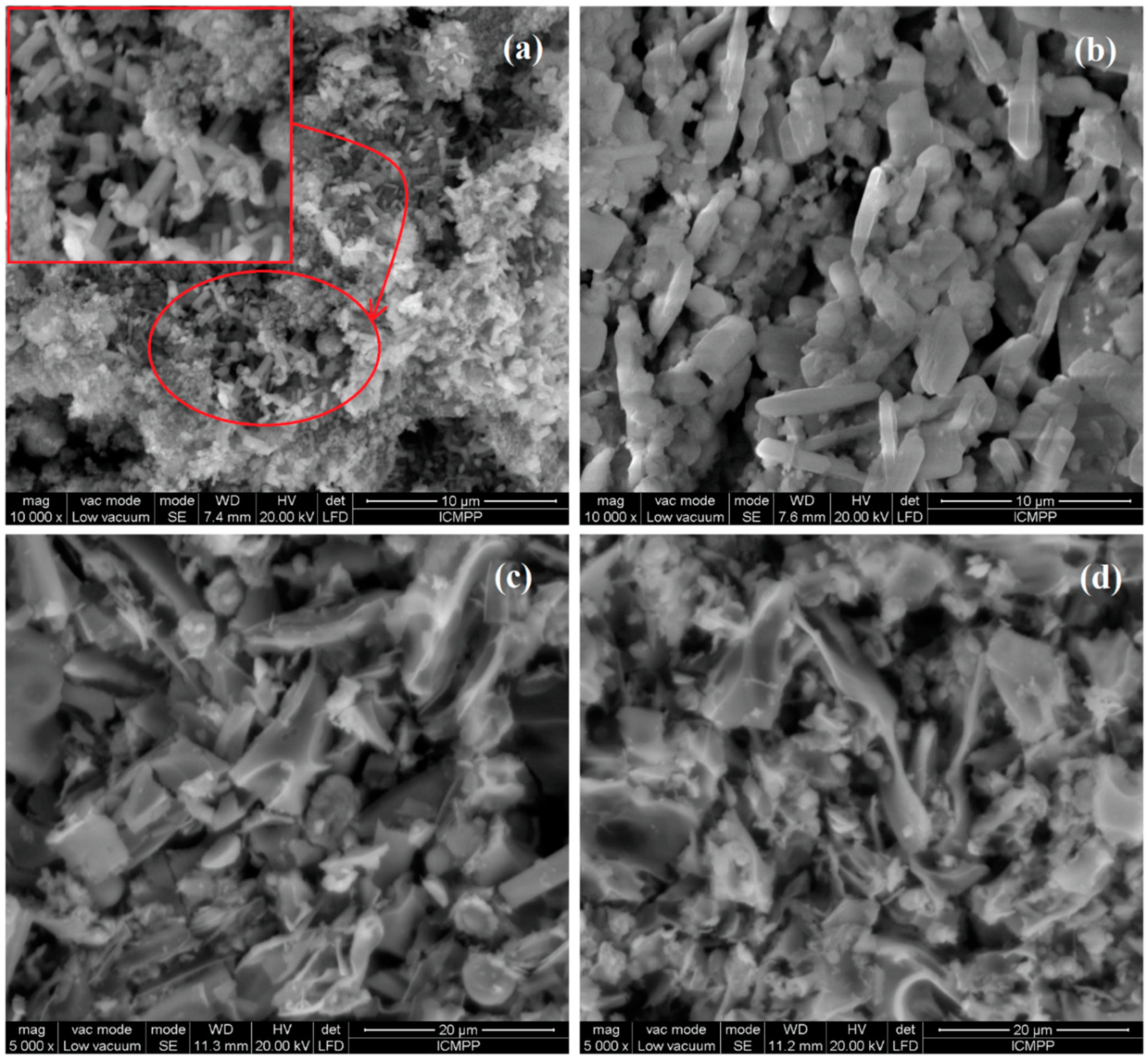
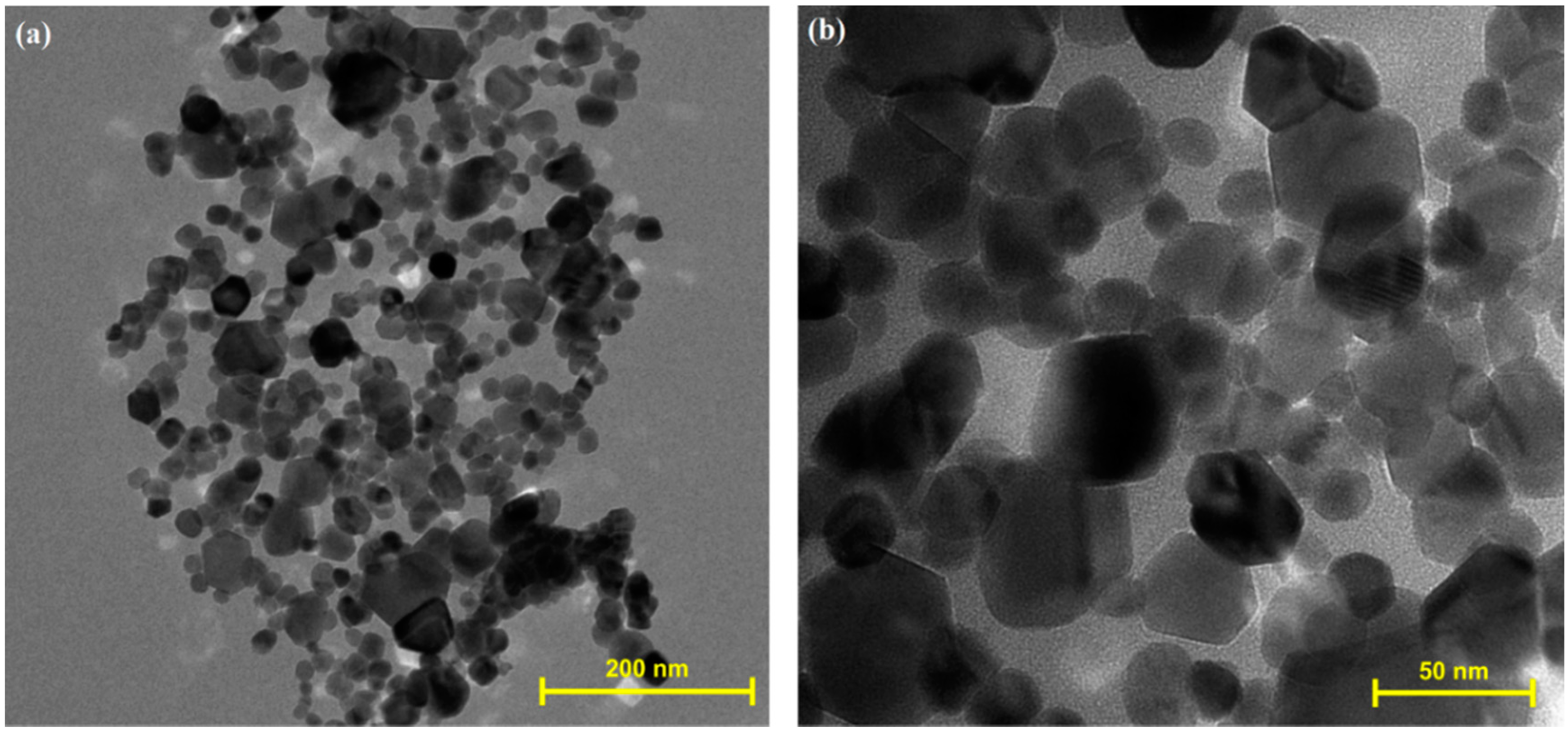

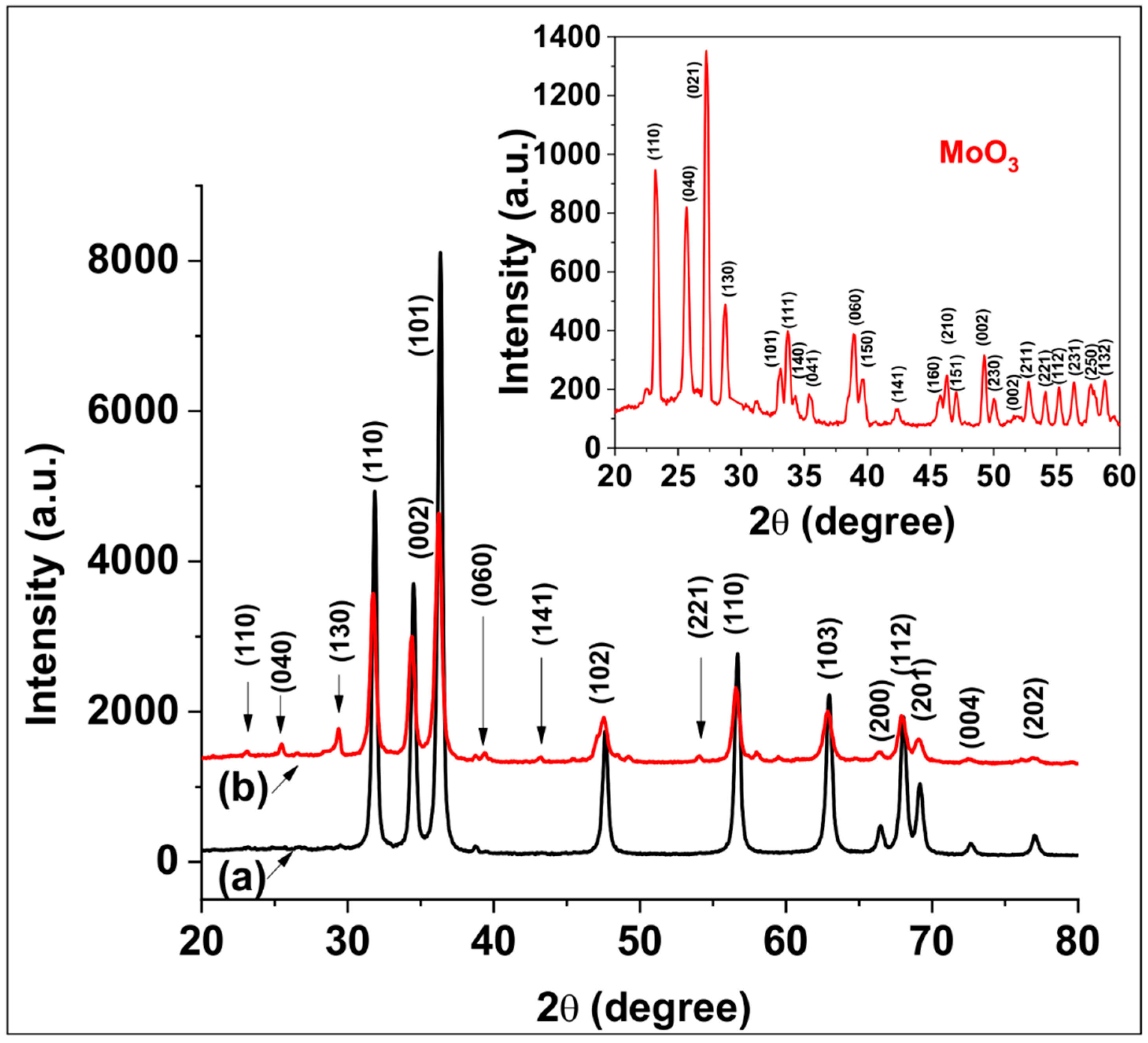

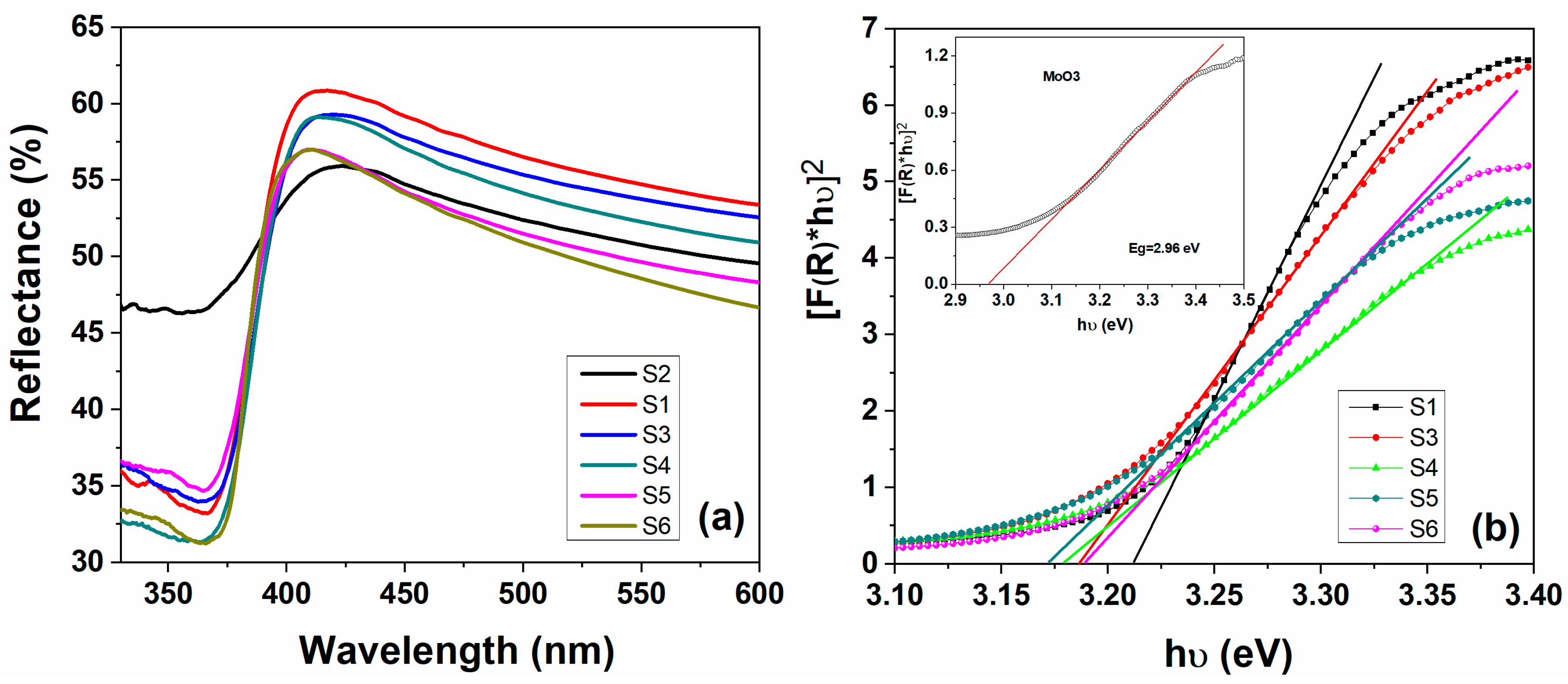
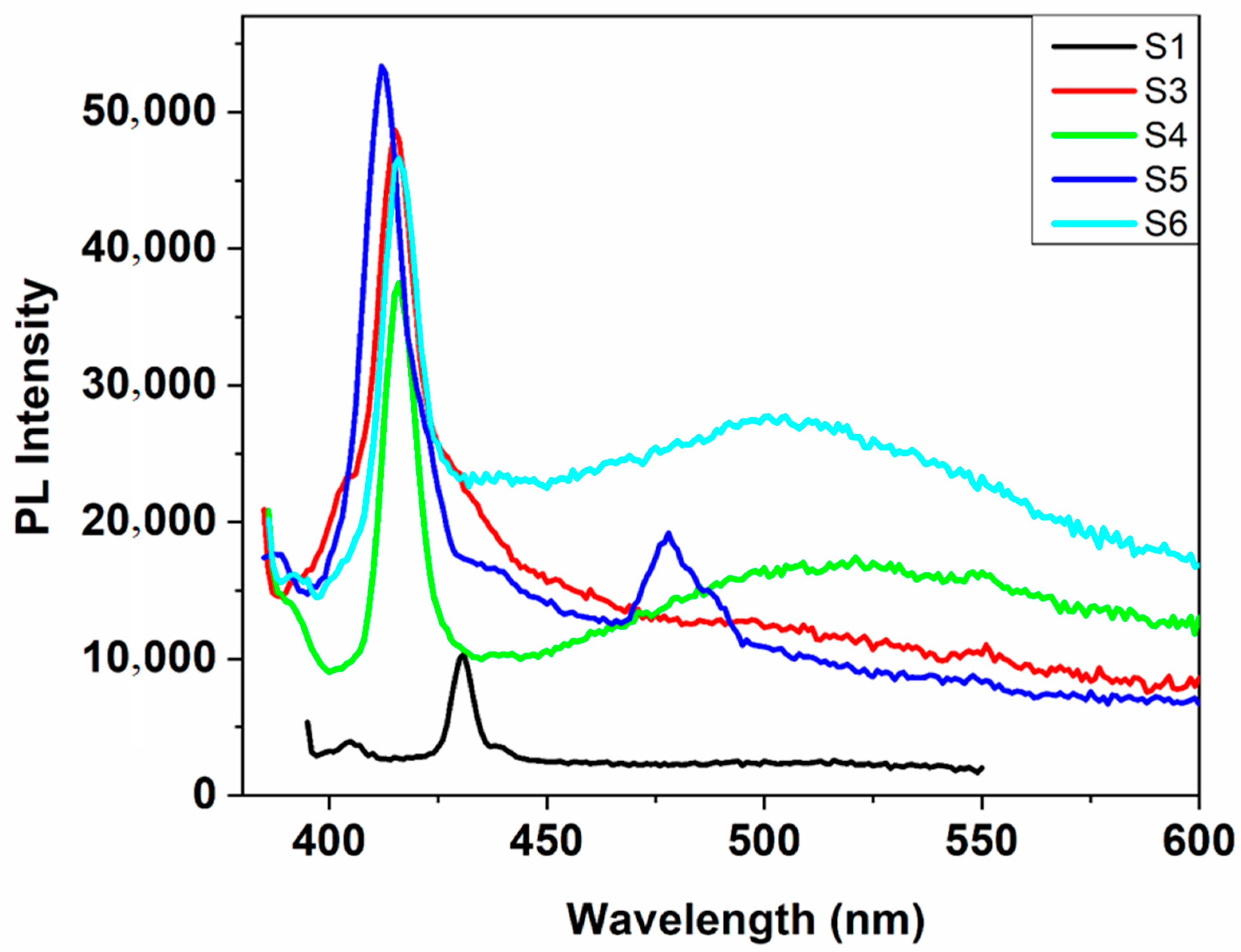
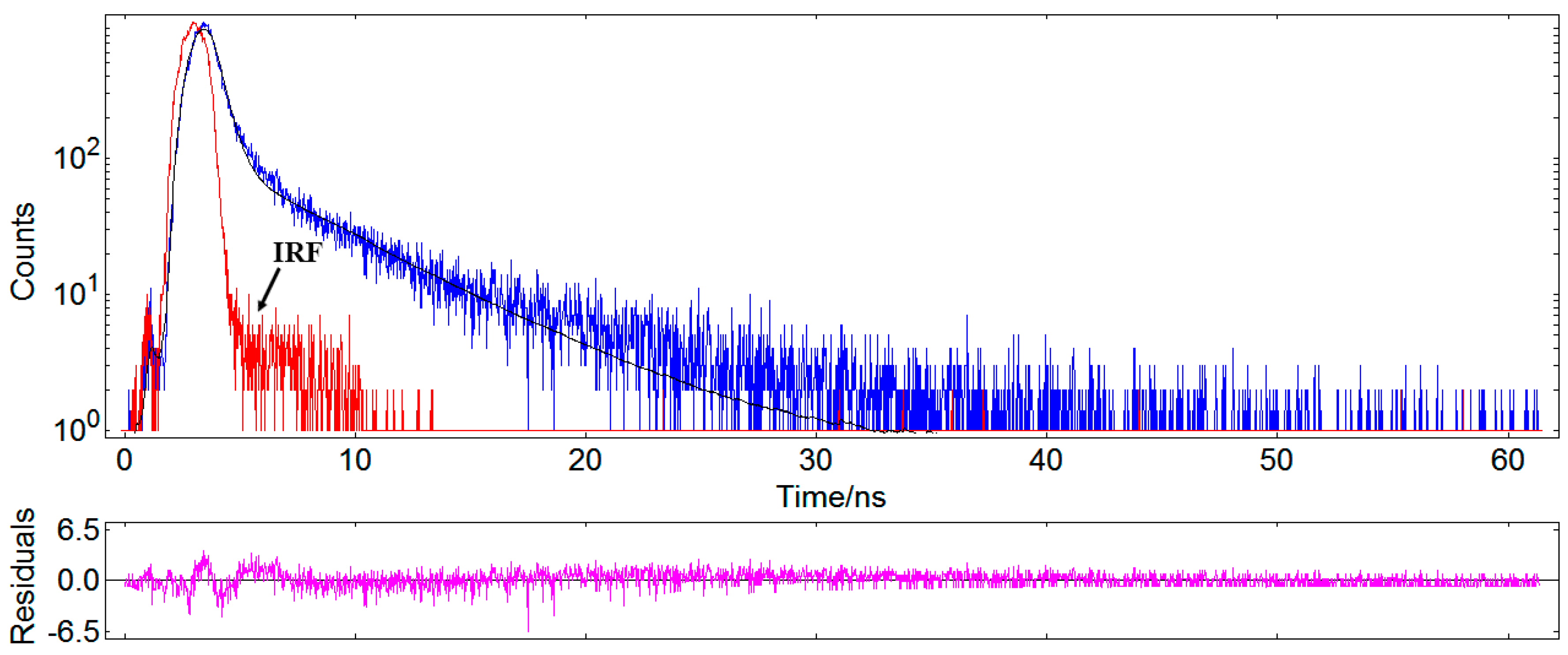
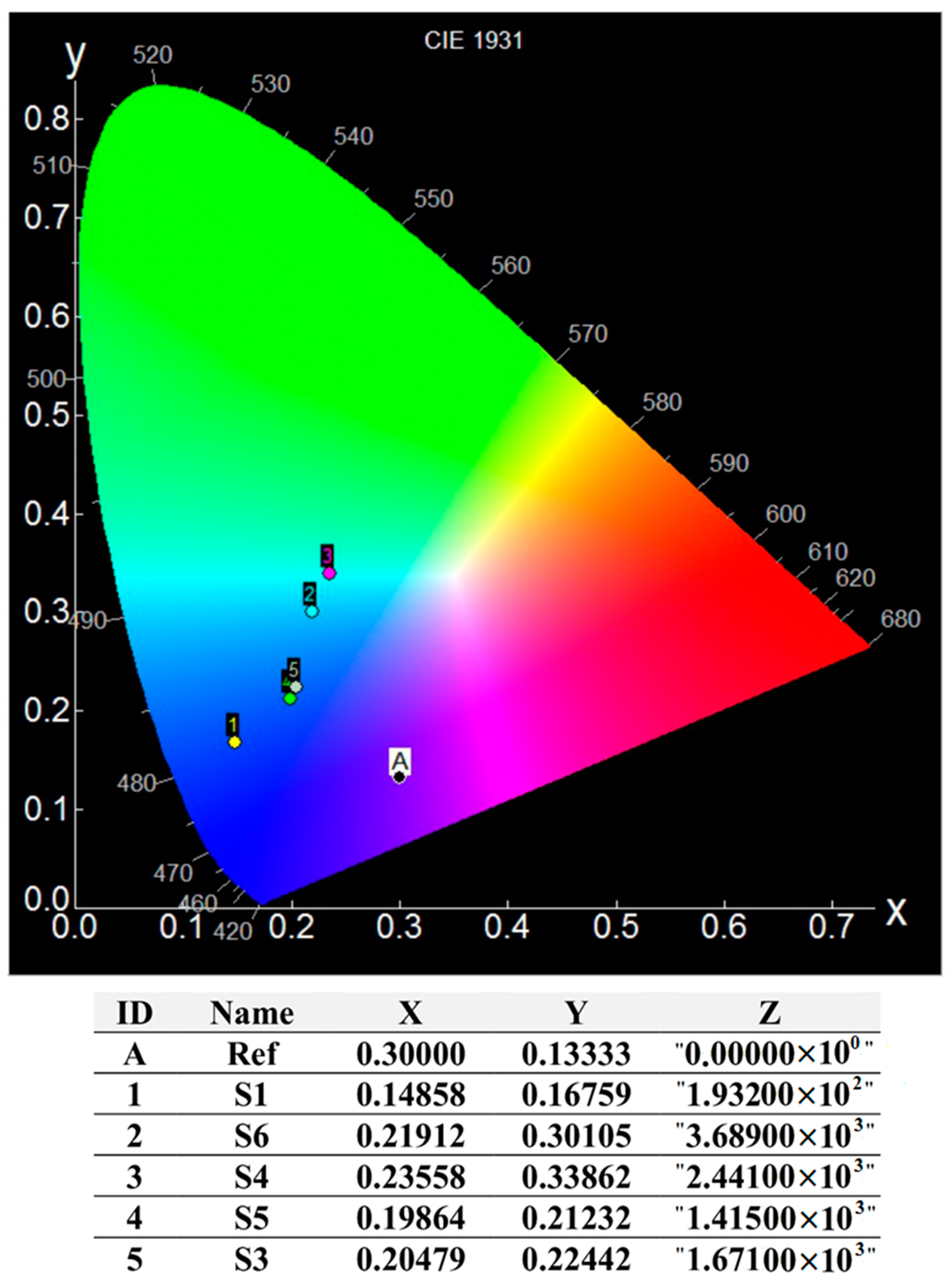
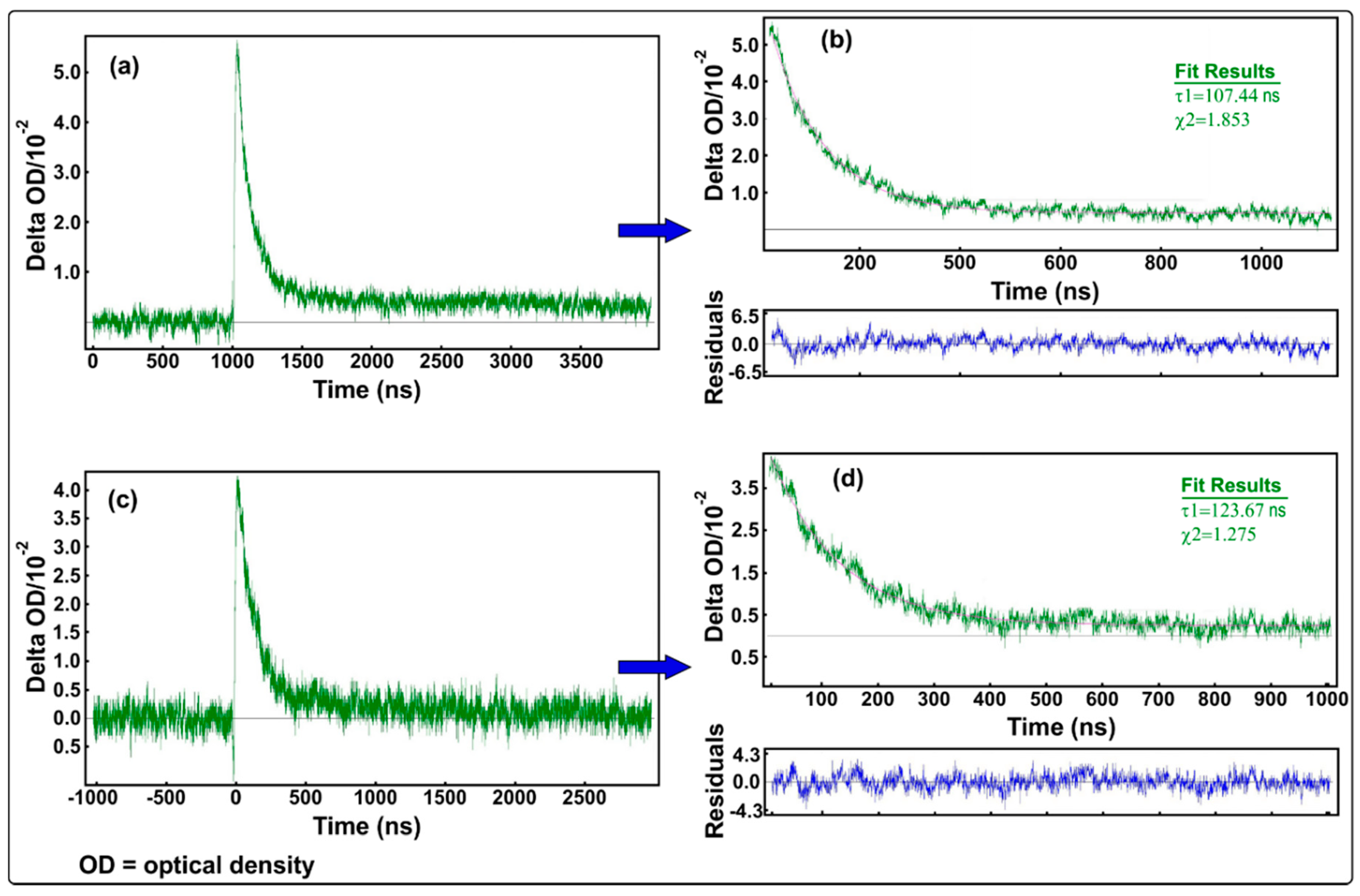
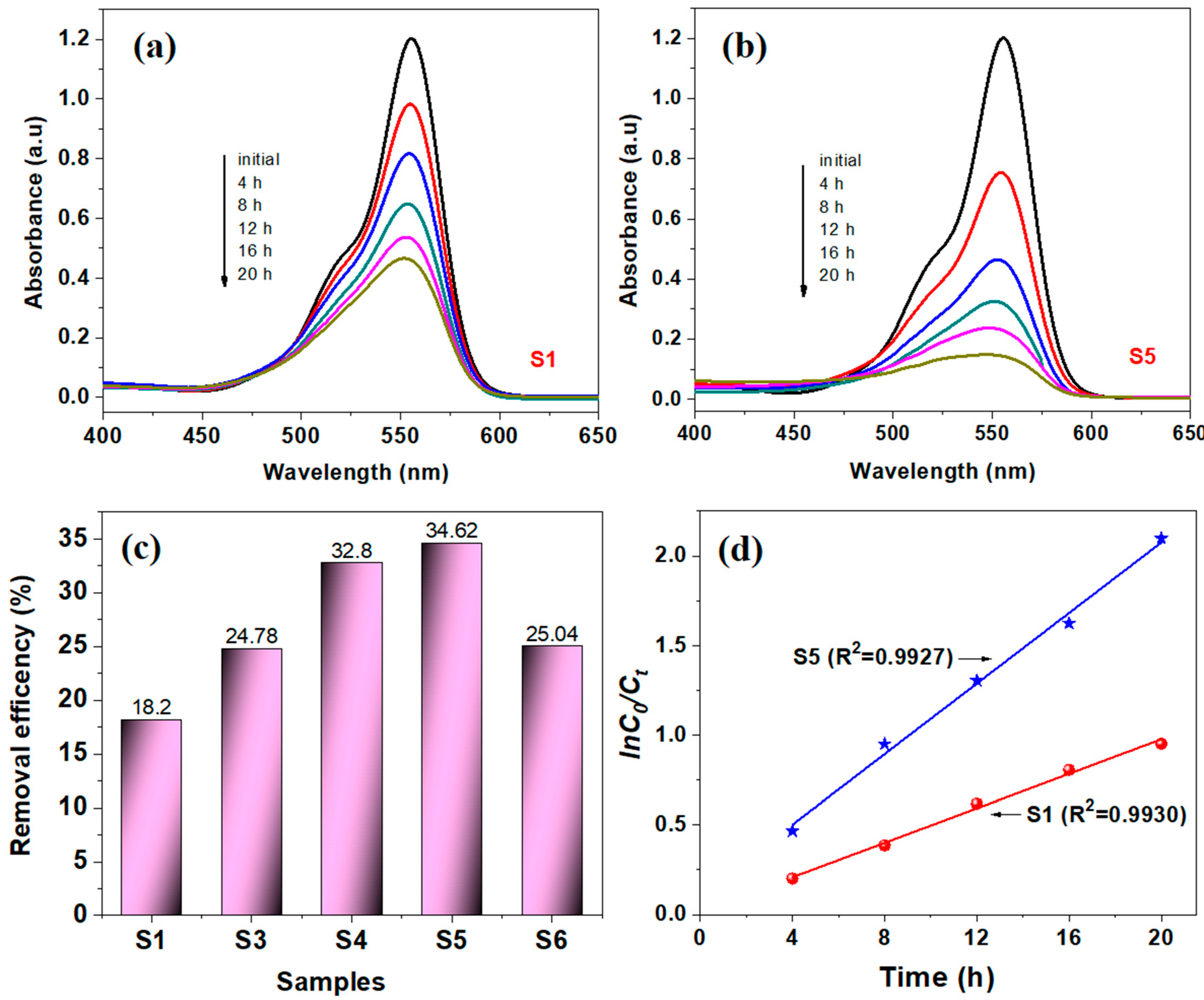
| Sample Codes | Composition of Precursor Salt | Atomic Molar Ratio Mo/Zn (%) | Atomic Concentration (%) Obtained from EDX | ||
|---|---|---|---|---|---|
| Zn (%) | O (%) | Mo (%) | |||
| S1 | 0.4 g Zn(NO3)2·6H2O | - | 53.08 | 46.92 | - |
| S2 | 0.4 g (NH4)6Mo7O24·4H2O | - | - | 72.23 | 26.77 |
| S3 | 0.4 g Zn(NO3)2·6H2O 0.002 g (NH4)6Mo7O24·4H2O | 0.84 | 51.20 | 47.85 | 0.92 |
| S4 | 0.4 g Zn(NO3)2·6H2O 0.004 g (NH4)6Mo7O24·4H2O | 1.66 | 53.86 | 44.62 | 1.51 |
| S5 | 0.4 g Zn(NO3)2·6H2O 0.008 g (NH4)6Mo7O24·4H2O | 3.26 | 53.29 | 44.67 | 2.30 |
| S6 | 0.4 g Zn(NO3)2·6H2O 0.012 g (NH4)6Mo7O24·4H2O | 4.81 | 50.55 | 44.62 | 4.82 |
| Codes | Eg | EVB (eV) | ECB (eV) |
|---|---|---|---|
| S1 | 3.210 | 2.890 | −0.310 |
| S3 | 3.186 | 2.883 | −0.303 |
| S4 | 3.177 | 2.878 | −0.298 |
| S5 | 3.170 | 2.875 | −0.295 |
| S6 | 3.189 | 2.884 | −0.304 |
| Codes | Fast Decay Component | Slow Decay Component | χ2 | |||
|---|---|---|---|---|---|---|
| τ1 (ns) | a1 (%) | τ2 (ns) | a2 (%) | |||
| S1 | 0.0664 | 74.06 | 4.1058 | 25.94 | 1.004 | 3.93 |
| S3 | 0.1068 | 51.95 | 5.3416 | 48.05 | 1.034 | 5.23 |
| S4 | 0.0624 | 76.76 | 4.6088 | 23.24 | 0.995 | 4.42 |
| S5 | 0.4654 | 72.68 | 5.0603 | 27.32 | 1.007 | 4.17 |
| S6 | 0.0662 | 74.05 | 4.0695 | 25.95 | 1.086 | 3.89 |
| Photocatalyst Type | Type and Concentration of Dyes | Amount Photocatalyst (g/mL) | Light Source | Reaction Rate Constant k (min−1) | Ref. |
|---|---|---|---|---|---|
| ZnO@h-MoO3 | Methylene Blue | 0.5 | Vis | - | [14] |
| ZnO:Mo (2%) | Orange II | 0.05/80 | UV | 0.0032 | [27] |
| ZnO:Mo (0.6%) | Direct Yellow 27 | 1/1000 | Vis (500 W) | 0.0007 | [36] |
| Acid Blue 129 | 1/1000 | 0.00085 | |||
| MoO3/ZnO | Methylene Blue | - | UV | 0.00138 | [37] |
| ZnO:MoO3 | Rhodamine B | 0.005/10 | Vis (100 W) | 0.0018 | This work |
© 2020 by the authors. Licensee MDPI, Basel, Switzerland. This article is an open access article distributed under the terms and conditions of the Creative Commons Attribution (CC BY) license (http://creativecommons.org/licenses/by/4.0/).
Share and Cite
Pascariu, P.; Homocianu, M.; Olaru, N.; Airinei, A.; Ionescu, O. New Electrospun ZnO:MoO3 Nanostructures: Preparation, Characterization and Photocatalytic Performance. Nanomaterials 2020, 10, 1476. https://doi.org/10.3390/nano10081476
Pascariu P, Homocianu M, Olaru N, Airinei A, Ionescu O. New Electrospun ZnO:MoO3 Nanostructures: Preparation, Characterization and Photocatalytic Performance. Nanomaterials. 2020; 10(8):1476. https://doi.org/10.3390/nano10081476
Chicago/Turabian StylePascariu, Petronela, Mihaela Homocianu, Niculae Olaru, Anton Airinei, and Octavian Ionescu. 2020. "New Electrospun ZnO:MoO3 Nanostructures: Preparation, Characterization and Photocatalytic Performance" Nanomaterials 10, no. 8: 1476. https://doi.org/10.3390/nano10081476
APA StylePascariu, P., Homocianu, M., Olaru, N., Airinei, A., & Ionescu, O. (2020). New Electrospun ZnO:MoO3 Nanostructures: Preparation, Characterization and Photocatalytic Performance. Nanomaterials, 10(8), 1476. https://doi.org/10.3390/nano10081476





